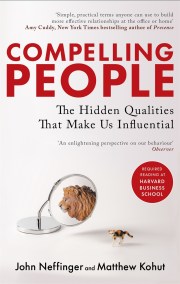How to influence people

Everyone wants to know how to be more influential. But most of us don’t really think we can have the kind of magnetism or charisma that we associate with someone like Bill Clinton or Oprah Winfrey unless it comes naturally. In this article, John Neffinger and Matthew Kohut share some of the secrets of public speaking from their book, Compelling People, which is now required reading and Harvard Business School.
In high-stakes situations like a big pitch, whether for a venture capital investment, a hefty contract from a client, or a partnership, you are being evaluated on a number of dimensions that correspond to strength and warmth. Your would-be partner wants to know you have something of significant value to offer, that you have a strong sense of the relevant business dynamics, and that you can deliver – all strength factors. They also want to know your interests are aligned, and that there is a good personal fit for a long-term relationship.
To close the sale, your story will have to include both a compelling way of establishing a shared interest as well as the business case for the proposal. The rest – a character judgment – will depend on earning the confidence of the other party and demonstrating that you are their kind of person. Depending on what kind of people they are, this may not call for high-wattage gregariousness – it may be about making clear your commitment to providing return on investment to shareholders, or some other serious concern that determines personal fit from their perspective. The warmth challenge in a big pitch is first and foremost about getting in the circle.
The most common mistake we see in presentations large and small is an overreliance on a PowerPoint deck to tell the story. A slide deck is a standard part of many big pitches, but too often it is used as a crutch – or worse, it tells the whole story, rendering you redundant. A self-explanatory slide deck you might e-mail someone to read on their own does not belong in a projection behind you, because that makes you irrelevant, or worse.
A friend of ours had a brother in the military, and he was given the critical assignment – and huge opportunity – of briefing a general on a mission-critical issue, with two weeks to prepare his presentation. He worked his butt off and got every slide just perfect. When the moment came, he walked the general through the first slide and then the second. As he turned to the third, the general spoke: ‘Is everything you need to say on those slides?’ ‘Yes sir,’ he replied. ‘Fine,’ said the general. ‘I will tell you when to flip.’ After weeks of preparation, the rest of his big meeting with the general he spent in silence, flipping slides ‘like Vanna White,’ as he told it. Most audiences will not be so candid with you. More likely, they will read each new slide you show them, and then go back to looking at their smartphone until you finish talking and turn to the next slide.
Ultimately your audience needs to believe in both you and your idea. Your deck may sell your idea, but it will not sell you. That means you should be the center of attention, not your slides. Know what you want to say first, and then use slides to illustrate key points along the way – but not every point, so you stay relevant and keep your audience’s attention.
Having a strong narrative is key. The story should be developed first, before the slides or other supporting materials; as we said earlier, it is the number one way into the circle. Even jaded skeptics will expect and respond positively to a good story, regardless of whether they proceed to challenge your business case and all the assumptions behind it. We once worked with a health care company that called us in a week before a big pitch to help them rehearse. In the first runthrough, the team members each spoke to several slides of a PowerPoint deck. They moved through it relatively smoothly, but the larger issue was that the presentation was about as memorable as a preflight safety briefing. There was no story that gave meaning or context to the problem the team was proposing to solve. After an hour or so of talking through this, one of the team members casually recounted an anecdote about a doctor involved in the project who had worked in a poor country that needed this breakthrough. A perfect story had been sitting in plain sight. After retooling the presentation around it, the team realized that the doctor protagonist would actually be the best messenger to bring the emotional element to life. A few phone calls later, the doctor agreed to tell his story on video as part of the pitch. We helped simplify the slides to support the overall narrative. The team called us the next week, excited that they had won the account. It was not magic; it was just good storytelling.
A good business case projects more than just competence. The assumptions and projections within it make a concrete statement about how you think the world works. Getting your audience to see the world as you do is a challenge of creating shared understanding – again, it comes back to the circle.
Compelling People
by John Neffinger
by Matthew Kohut
'This is not just another pop-psych book: it's the first book to capture and share the insights from all the recent groundbreaking research on how we judge and persuade each other. And it translates that into simple, practical terms anyone can use to build more effective relationships at the office or home' Amy Cuddy
HOW PEOPLE JUDGE YOU - AND HOW TO COME OUT LOOKING GOOD
Everyone wants to know how to be more influential. But most of us don't really think we can have the kind of magnetism or charisma that we associate with someone like Bill Clinton or Oprah Winfrey unless it comes naturally.
In Compelling People - now required reading at Harvard Business School - John Neffinger and Matthew Kohut show that this isn't something we have to be born with, it's something we can learn. They trace the path to influence through a balance of strength and warmth. Each seems simple, but only a few of us figure out the tricky task of projecting both at once.
Drawing on cutting-edge social science research as well as their own work with Fortune 500 executives, members of Congress, TED speakers and Nobel Prize winners, Compelling People explains how we size each other up - and how we can learn to win the admiration, respect, and affection we desire.








